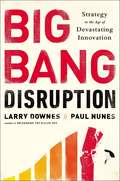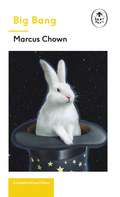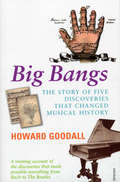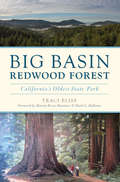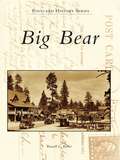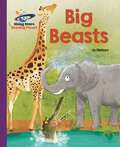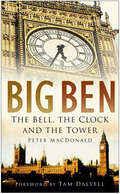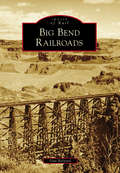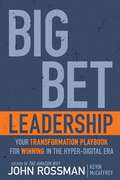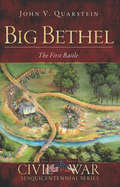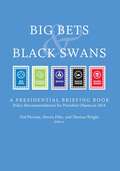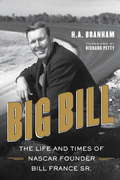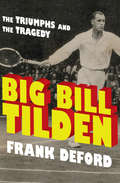- Table View
- List View
Big Bang Being: Developing the Sustainability Mindset
by Ervin Laszlo Isabel RimanoczyWhen asked for the definition of mental health and fulfilment, Sigmund Freud had two words: lieben und arbeiten, love and work. In this book we will find how 16 business leaders brought together their compassion, their caring for others and the world, with their work.True, only on rare occasions are we able to meet the person behind initiatives that made a positive impact on the world, even less have an in-depth view into their feelings, concerns, hesitations, doubts and most intimate thoughts. What is seen publicly is the initiative, the impact on the bottom line and the community, or sometimes on the environment. Yet it is their _personal_ stories that can be most inspirational, since they draw our attention to the fact that amazing achievements start in simple ways, with just the thinking of one individual. And when we find out that the "exemplary individuals" have many very "human" aspects that we identify with and find in ourselves, it brings us closer; and, particularly, it may even trigger in us the question: If she could do it... I wonder what could _I_ do?The interviews, however, were only the beginning of the journey. The lessons of the interviews made it possible to identify how we can all develop a sustainability mindset: in other words, the thinking and the being that can take us from breakdown to breakthrough on this planet. Each one of us can play a part in leading the change; in fact, we are already playing a part – we are just not necessarily aware if that is the part we would like to play, or aware that we choose the change we are contributing to unfold.Part I presents the 16 leaders, including a summary of their story and their initiatives. Part II goes a little deeper, as you will find two dimensions that were not obvious but which underlie the way these business leaders championed the initiatives: the Thinking and the Being. Part III explores why sustainability change is so slow, and addresses the "elephant in the room": the values and beliefs that anchor our Western Weltanschauung, or worldview. Part IV addresses the alternatives that we have to convert the unsustainable values into opportunities that will permit humanity to thrive and to break through the obstructions that prevent us from stasis. Finally, Part V takes us beyond the tipping point, and presents us with an opportunity to evolve as humans developing a new way of thinking and being on this planet. This transformation is so radical and significant, that the author calls it the Big Bang Being.
Big Bang Disruption
by Larry Downes Paul NunesIt used to take years or even decades for disruptive innovations to dethrone dominant products and services. But now any business can be devastated virtually overnight by something better and cheaper. How can executives protect themselves and harness the power of Big Bang Disruption? Just a few years ago, drivers happily spent more than $200 for a GPS unit. But as smartphones exploded in popularity, free navigation apps exceeded the performance of stand-alone devices. Eighteen months after the debut of the navigation apps, leading GPS manufacturers had lost 85 percent of their market value. Consumer electronics and computer makers have long struggled in a world of exponential technology improvements and short product life spans. But until recently, hotels, taxi services, doctors, and energy companies had little to fear from the information revolution. Those days are gone forever. Software-based products are replacing physical goods. And every service provider must compete with cloud-based tools that offer customers a better way to interact. Today, start-ups with minimal experience and no capital can unravel your strategy before you even begin to grasp what's happening. Never mind the "innovator's dilemma"--this is the innovator's disaster. And it's happening in nearly every industry. Worse, Big Bang Disruptors may not even see you as competition. They don't share your approach to customer service, and they're not sizing up your product line to offer better prices. You may simply be collateral damage in their efforts to win completely different markets. The good news is that any business can master the strategy of the start-ups. Larry Downes and Paul Nunes analyze the origins, economics, and anatomy of Big Bang Disruption. They identify four key stages of the new innovation life cycle, helping you spot potential disruptors in time. And they offer twelve rules for defending your markets, launching disruptors of your own, and getting out while there's still time. Based on extensive research by the Accenture Institute for High Performance and in-depth interviews with entrepreneurs, investors, and executives from more than thirty industries, Big Bang Disruption will arm you with strategies and insights to thrive in this brave new world.
Big Bang, Baby: Rock Trivia
by Richard CrouseIn the middle of the conservative 1950s, rock and roll hit popular culture like an explosion a Big Bang, Baby! And the fallout from that explosion is still electrifying music fans today. Popular music expert Richard Crouse has ventured deep into the far reaches of rock history to bring together this dynamic collection of facts and oddities. Big Bang, Baby will entertain and enlighten music fans of all eras and will challenge even experienced rock trivia junkies.
Big Bang: Discover how the universe began
by Marcus ChownWhat really happened in the Big Bang? Learn from the experts in the ALL-NEW LADYBIRD EXPERT SERIESThe Big Bang is an accessible, authoritative introduction for anyone looking to understand how the universe came to be.The greatest discovery in the history of science is that the universe has not existed forever but was born. There was a day without a yesterday . . .Written by award-winning writer and former astrophysicist Marcus Chown, The Big Bang details how 13.82 billion years ago all matter, energy, space - and even time - erupted into being in a titanic fireball.This mind-bending book addresses the big questions: What was the Big Bang? What drove the Big bang? And what happened before the Big Bang?Inside you'll discover:- What Einstein missed- Why the universe is expanding- The elements that made up the Big Bang- Where the universe came from- And much more . . .The evidence for the Big Bang, it turns out, is all around us...Learn about other topics in the Ladybird Experts series including Gravity, Quantum Physics, Climate Change and Evolution.Written by the leading lights and most outstanding communicators in their fields, the Ladybird Expert books provide clear, accessible and authoritative introductions to subjects drawn from science, history and culture. For an adult readership, the Ladybird Expert series is produced in the same iconic small hardback format pioneered by the original Ladybirds. Each beautifully illustrated book features the first new illustrations produced in the original Ladybird style for nearly forty years.
Big Bangs
by Howard GoodallThe dramatic story of five key turning points in a thousand years of Western music - discoveries that changed the course of history. Who first invented 'Doh Re Mi...'?What do we mean by "in tune"?Looking back down the corridor of a thousand years, Howard Goodall guides us through the stories of five seismic developments in the history of Western music. His "big bangs" may not be the ones we expect - some are surprising and some are so obvious we overlook them - but all have had an extraordinary impact. Goodall starts with the invention of notation by an 11th-century Italian monk, which removed the creation of music from the hands of the players to the pens of the composers; moves on to the first opera; then to the invention of the piano, and ends with the story of the first recording made in history. Howard Goodall has the gift of making these complicated musical advances both clear and utterly fascinating. Racy and vivid in a narrative full of colourful characters and graphic illustrations of technical processes, he also gives a wonderful sense of the culture of trial and error and competition, be it in 11th-century Italy or 19th-century America, in which all progress takes place. Big Bangs opens a window on the crucial moments in our musical culture - discoveries that made possible everything from Bach to the Beatles - and tells us a riveting story of a millennium of endeavour.
Big Basin Redwood Forest: California's Oldest State Park (Landmarks)
by Traci BlissThe epic saga of Big Basin began in the late 1800s, when the surrounding communities saw their once "inexhaustible" redwood forests vanishing. Expanding railways demanded timber as they crisscrossed the nation, but the more redwoods that fell to the woodman's axe, the greater the effects on the local climate. California's groundbreaking environmental movement attracted individuals from every walk of life. From the adopted son of a robber baron to a bohemian woman winemaker to a Jesuit priest, resilient campaigners produced an unparalleled model of citizen action. Join author Traci Bliss as she reveals the untold story of a herculean effort to preserve the ancient redwoods for future generations.
Big Bazaar
by Ananth Raman Laura WinigDescribes a high-growth Indian retailer, Pantaloon Retail (India) Ltd., and two of the company's formats--Big Bazaar and Food Bazaar. Challenges students to debate the company's concept, its strategic decision on how quickly it would like to grow, and some key decisions on its supply chain. At the time of the case (2006), small "mom-and-pop" stores still dominated Indian retailing, but that was changing rapidly because of the entry of "organized" retailers such as Pantaloon. Pantaloon's management faced some exciting opportunities as well as some potential competition from global retailers that were planning to enter the Indian market and large Indian business houses that were planning to establish retailing businesses.
Big Bear
by Russell L. Keller Stanley E. BellamyIn 1845, Benjamin Davis Wilson--the future first mayor of Los Angeles and the grandfather of Gen. George S. Patton--led a 20-man posse into the San Bernardino Mountains in search of Native American raiding parties that had been attacking Riverside ranches. But what they found in a particular high-altitude valley were, instead, large and furry. Wilson's men soon roped 11 bears, bringing the creatures into camp, and the valley the Serrano Indians knew as Yuhaviat, or "Pine Place," received a new map designation. Wilson named a nearby body of water Big Bear Lake (now Baldwin Lake, with the present-day, man-made lake co-opting the bruin moniker). Today, at elevations between 6,000 and 9,000 feet, the city of Big Bear Lake is an hour and a half from Los Angeles and a million miles from the rat race, where hiking, sports, and the absence of exertion thrive in a vacation atmosphere.
Big Bear (Postcard History Series)
by Russell L. KellerBig Bear is known throughout the southland of California as an outdoor recreational destination. Located high atop the San Bernardino Mountains, the area was once home to the Yuhaviatam Indians, the "People of the Pines." In 1845, a party lead by Benjamin Davis Wilson, the grandfather of Gen. George S. Patton, entered the valley and discovered the area alive with grizzly bears, giving the valley its name. A dam, completed in 1884, created Big Bear Lake, which provided water to citrus growers in the area of Redlands and later lead to the water-related recreations, camps, resorts, and the welcoming community that Big Bear is famous for today.
Big Bear: A Biography (Canadian Biography Ser.)
by J.R. MillerA biography of the Plains Cree chief who challenged Canadian authorities and became a warrior of legend. When Big Bear was young, in the first half of the nineteenth century, he overcame smallpox and other hardships—and eventually followed in the footsteps of his father, Black Powder, engaging in warfare against the Blackfoot. The time would come for him to draw on these experiences and step into a leadership role, as the buffalo began to disappear and his people suffered. This rich historical biography tells of Big Bear&’s role as chief of a Plains Cree community in western Canada in the late nineteenth century, at a time of transition between the height of Plains Indian culture and the modern era. During the 1870s and early 1880s, Big Bear became the focal point of opposition for Cree and Saulteaux bands that did not wish to make treaty with Canada. During the early 1880s, he spearheaded a Plains diplomatic movement to renegotiate the treaties in favor of the Aboriginal groups whose way of life had been devastated. Although Big Bear personally favored peaceful protest, violent acts by some of his followers during the North-West Rebellion of 1885 provided the federal government with the opportunity to crush him by prosecuting him for treason. His story provides fascinating insight into this era of North American history.
Big Belching Bog
by Phyllis RootCold, wet, and acidic, bogs appear to be extremely hostile to life, yet numerous plants and animals have adapted in fascinating ways in order to survive there. In Big Belching Bog, Phyllis Root lets us in on the secrets of the mysterious bog, describing such special inhabitants as plants that eat insects, bog lemmings, and frogs that stay frozen through the winter and thaw out in the spring. But what's that coming up from the bottom of the bog? The biggest bog secret of all, we learn, is the remarkable process of methane gas belching out of the bog. The gas is created by decaying peat moss and forms a bulge in the surface of the moss six inches or taller before breaking through. Does this "belch" make a sound? No one knows, says Root, because no one has ever heard it. In fact, bogs are known as some of the quietest places on earth. Maybe you will be the first to hear the big bog belch! Illustrated by renowned woodcut artist Betsy Bowen, Big Belching Bog also contains a section of bog facts, including more information about the plants and animals mentioned in the book as well as tips for visiting a bog. Big Belching Bog will stir the imagination of young readers and teach them about the landscape and environment of these mysterious and, ahem, gassy places.
Big Ben: The Bell, the Clock and the Tower
by Peter MacDonaldBig Ben is perhaps the most famous clock in the world. Here is its story, from its conception in the 1830s, after the fire destroyed the Palace of Westminster, to its establishment as the national timepiece and the symbol of Britain up to the present day. Big Ben is a character, an icon known to millions through the film The Thirty-Nine Steps - in which one of the protagonists clings to the hands as he swings above London - but above all it is a masterpiece of horological engineering intended to set the time for Parliament. Designed and built by the most forward-thinking of clockmakers, it represents the pinnacle of turret clockbuilding.While the music of the bells is mellow and harmonious, the clock's history was not. It took twenty-five years of bitter rivalry, backbiting and legal proceedings before it was finished. The engaging book tells in anecdotal style the story of the clock, reveals how the bell was cast, how it was named, how the music was composed and how the clock is maintained.
Big Bend Railroads
by Dan BolyardThe Big Bend area had its start with a land grant given by President Lincoln to the Northern Pacific Railway. As such, the railway company heavily promoted the area to encourage settlement and populate the station sites along the way. Towns began to develop in the late 1880s; prior to that time, the few settlers had a difficult time getting around. Despite snow, floods, fires, wrecks, human error, sabotage, and government regulation, the railroads continued and were able to serve the communities and help them survive. The earliest lines were built largely by man and beast with few large machines. The last transcontinental line in the Big Bend, the Milwaukee Road, featured groundbreaking technology in the form of electrically operated locomotives. The building of Grand Coulee Dam brought more railroad lines, with tracks that featured grades and locomotives normally seen on logging railroads, to bring in construction materials to the largest concrete structure in the world at the time.
Big Bend Tales
by Mike CoxTravel deeper into the Texas outback with writer-historian Mike Cox as he recounts the lesser-known stories from Alpine, Fort Davis and Marfa. Revisit the grandeur of Alpine's Holland Hotel, peer through the telescope at the McDonald Observatory and dip your toes in the water hole at Ernst Tinaja, if you dare. Travel back to a time when the Comanche Trail stretched one thousand miles from Kansas to Mexico, making the Big Bend difficult to defend and impossible to resist trying. Celebrate Cinco de Mayo, the anniversary of Benito Juarez's decisive defeat of the French at Pueblo in 1867. If nothing else, come for the lore and history that is as extensive in the Big Bend region as the mountain passes and desert stretches themselves.
Big Bend: A Homesteader's Story
by Fred Gipson J.O. LangfordA first-hand account of a chronically ill man who uproots his family to settle on the banks of the Rio Grande, written with the author of Old Yeller. To the wild and fabulous country where the Rio Grande makes its big bend, J. O. Langford came in 1909 with his wife and daughter in search of health and a home. High on a bluff overlooking the spot where Tornillo Creek pours its waters into the turbulent Rio Grande, the Langfords built their home, a rude structure of adobe blocks in a land reputed to be inhabited only by bandits and rattlesnakes.Big Bend is the story of the Langfords&’ life in the rugged and spectacularly beautiful country which they came to call their own. Langford&’s account is told with the help of Fred Gipson, author of Old Yeller and Hound Dog Man. &“Big Bend. . . is the story of a way of life, beautiful in its simplicity, a story that can be read again and again for it is a book of substance.&” —New York Herald Tribune &“Not a big book this, but as warming to the senses and to the heart as a mesquite fire on the open hearth. It is, also, a book that reflects a commonality of the Western experience of this Nation—a homesteader&’s story.&” —San Francisco Chronicle &“This is one of those rare books of actual experience with the smooth continuity of the best fiction.&” —Houston Chronicle
Big Bend: A Homesteader's Story
by Fred Gipson J. O. LangfordTo the wild and fabulous country where the Rio Grande makes its big bend, J. O. Langford came in 1909 with his wife and daughter in search of health and a home. High on a bluff overlooking the spot where Tornillo Creek pours its waters into the turbulent Rio Grande, the Langfords built their home, a rude structure of adobe blocks in a land reputed to be inhabited only by bandits and rattlesnakes. Big Bend is the story of the Langfords' life in the rugged and spectacularly beautiful country which they came to call their own. Langford's account is told with the help of Fred Gipson, author of Old Yeller and Hound Dog Man.
Big Bertha's Big Trip (Fountas & Pinnell Classroom, Guided Reading)
by Alice CaryNIMAC-sourced textbook. BIG PLANS FOR A BIG CRUISER. The huge red machine was called the Snow Cruiser, and no one had ever seen anything like it. It was built to travel over ice in Antarctica. But how would it get to the bottom of the world?
Big Bet Leadership: Your Transformation Playbook for Winning in the Hyper-Digital Era
by John Rossman Kevin McCaffreyThe Executive Playbook to Lead Business Growth, Innovation and Transformation.The first leadership book for the age of artificial intelligence, equipping leaders with principles and tactics to achieve audacious outcomes and solve complex problems, while smartly managing the inherent risks of bold moves. Applying this playbook will impact your business and, just as critically, propel and protect your career as a bold transformational executive. Co-authored by John Rossman, author of The Amazon Way and Think Like Amazon, and Kevin McCaffrey, seasoned executives from Amazon, Google, and T-Mobile. This fast-moving book melds their direct leadership experiences with comprehensive research and authentic stories. Actionable insights include: Pinpointing Growth Opportunities: Identify your customer's primary frustrations and unmet needs with standout features, forming the foundation for sustainable business growth. Mastering Strategic Communication: Develop skills to ensure alignment, clarity, and vital stakeholder involvement through effective strategic communication. Prioritizing through High-Impact Experimentation: Implement cost-effective, swift, and impactful experimentation methods, utilizing memos and debates for maximum effect. Redefining Cost Models for Winning Business Models: Learn to innovate cost structures alongside improving customer experiences for a transformative impact on your business. Overcoming Inertia and Analysis Paralysis: Discover tactics to break free from conventional pace and decision-making traps by creating focused teams and unique operational environments. Maximizing Return on Effort: Craft a governance approach that provides high quality, timely signals for your strategic endeavors without the usual bureaucratic overhead. With your book purchase you also get a trove of resources including practical frameworks, real-world examples, a Big Bet journal, generative AI prompts , and a Big Bet GPT. These tools are designed to drive active integration of the principles of Big Bet Leadership in your business.
Big Bethel: The First Battle (Civil War Series)
by John V. QuarsteinThe battle at Virginia's Big Bethel Church, known as the Civil War's first land battle, was a baptism of fire for a nation newly torn apart by civil war. Northern and Southern soldiers alike could not imagine how fiery passions and technological advances would collide into America's bloodiest war, all beginning that hot, cloudless day at Bethel, as the shells burst among the smartly clad Zouaves. Here, the war saw its first friendly fire incident, the death of the first West Point graduate, the death of the first Confederate infantryman and the first Confederate victory. Join award-winning historian John Quarstein as he details the story of the June 10, 1861 battle, when soldiers first realized that the war would not be filled with glorious parades but rather desperate struggles to decide the fate of the nation.
Big Bets and Black Swans 2014
by Thomas Wright Ted Piccone Steven PiferPresident Obama has just three years left in office to define his legacy in world affairs. He's facing a number of critical challenges-the ongoing war in Syria, the Iran nuclear negotiations, an enigmatic North Korea and other significant crises in world affairs. The president's advisors are busy devising policy recommendations aimed at grappling with these thorny issues. From these, the president must decide which priorities to pursue and how to best exercise U.S. power and influence to manage and shape the global order.This book presents a set of policy analysis and recommendations from The Foreign Policy scholars at the Brookings Institution. Designed to provide the White House with innovative and actionable policy initiatives, the book is constructed as a series of memos to President Obama. This year, the memos are divided into five categories: Big Bets are issues where the president should consider investing his power, time and prestige in major efforts that can have a transformational impact on America and the world. Double Downs are derived from the Big Bets from last year's recommendations that the president should redouble his efforts on. Black Swans are those low-probability but high-impact events that can divert the president and his administration's higher purposes, such as dramatic negative events that he will want to take steps in advance to avoid or to mitigate their consequences. Nightmares are events that look more likely than a Black Swan and could prove particularly troublesome for U.S. interests and the global order, and for which the administration should prepare. Holds are updated policy recommendations to stay the course on approaches suggested last year.
Big Bets: How Large-Scale Change Really Happens
by Rajiv Shah&“Encouraging…Uplifting...Meeting apparently insurmountable goals requires thinking big…this will inspire.&” —Publishers Weekly &“Raj Shah has written a practical guide to making the world a better place. He knows what he&’s talking about, because he&’s done it himself. Anyone who wants to make a change in the world, or their own lives, will benefit from this book.&” —Bill Gates, Cochair, Bill & Melinda Gates Foundation Rajiv J. Shah, president of the Rockefeller Foundation and former administrator of President Barack Obama&’s United States Agency for International Development, shares a dynamic new model for creating large scale change, inspired by his own involvements with some of the largest humanitarian projects of our time.Rajiv J. Shah is no stranger to pulling off the impossible, from helping vaccinate 900 million children at the Bill & Melinda Gates Foundation to a high-pressure race against the clock to stop the spread of Ebola. His secret? A big bets philosophy—the idea that seeking to solve problems rather than make incremental improvements can attract the unlikely partners with the power and know-how to achieve transformational change. Part career sweeping memoir, part inspirational playbook, Big Bets offers a master class in decision-making, leadership, and changing the world one bet at a time. Shah animates his strategic insights with vivid behind-the-scenes stories, memorable conversations with household names that helped shape his approach to creating change, and his own personal growth as an Indian-American from an immigrant family looking for a way to belong. He distills his battle-tested strategies for creating change, arguing that big bets have a surprising advantage over cautious ones: a bold vision can attract support, collaborations, and fresh ideas from key players who might otherwise be resistant. Throughout the book, Shah traces his unlikely path to the Rockefeller Foundation across a changing world and through some of the most ambitious, dramatic global efforts to create a better world.
Big Bill
by H. A. BranhamThe first major authorized biography of NASCAR founder, Bill France Sr.Big Bill is the consummate "insider" book on the life and legend of NASCAR founder Bill France and tells the tale of a classic American success story. France Sr. brought his family to Daytona Beach, Florida, in 1934, put down roots and immersed himself in the business of racing, both as a driver and an owner. Nicknamed "Big Bill" because of his 6-foot-5 stature, he made significant contributions to the racing world - he founded NASCAR in December 1947, built Daytona International Speedway in 1959 and built Talladega Superspeedway in 1969, and landed the landmark R.J. Reynolds/Winston sponsorship deal in 1971 that not only transformed NASCAR but also transformed corporate sponsorship of sports in America. The France family has spent the last 30 years gathering a vast collection of files and material about their family patriarch and has turned over countless interviews -- both written and taped -- as well as NASCAR documents, memorabilia, memos, letters and various other materials to the author for this definitive biography. Big Bill offers NASCAR fans a rich, entertaining, emotional, and detailed story about America's most recognized and admired racing family.
Big Bill Tilden: The Triumphs and the Tragedy
by Frank Deford&“A compelling, long overdue tribute&” to America&’s first tennis star from the renowned sportswriter and author of Everybody&’s All-American (Kirkus Reviews). When he stepped onto the Wimbledon grass in 1920, Bill Tilden was poised to become the world&’s greatest tennis star. Throughout the 1920s he dominated the sport, winning championship after championship with his trademark grace, power, and intelligence. He owned the game more completely than Babe Ruth ruled baseball, making his name, for more than a decade, synonymous with tennis. Phenomenally intelligent—he completed his first book on tennis in the three weeks before his first Wimbledon triumph—Tilden&’s success came with a dark side. This classic biography by legendary sports writer Frank Deford tells of Tilden&’s dominance, which was unlike anything the sport had ever seen—and the big man&’s tragic fall.

